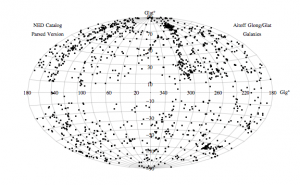One of the challenges of ground based astronomy is that Earth’s atmosphere is between us and the stars. Our atmosphere not only leads to the twinkling effect we see with stars, but it also absorbs many of the wavelengths of light we’d like to observe. One solution is to put telescopes in space. Another is to locate them at extremely high altitudes. But for some wavelengths such as infrared a high plateau isn’t high enough, but launching a telescope into space is excessively expensive. A compromise is to put a telescope on an airplane.
SOFIA, or the Stratospheric Observatory for Infrared Astronomy, is a modified 747 with a 2.5 meter infrared telescope. It operates at an altitude of 12,500 meters (41,000 feet). At that altitude the atmosphere absorbs only about 15% of infrared light. So SOFIA is able to get infrared images that simply aren’t possible from the ground.
The main mission of SOFIA is to look at things like interstellar gas and the atmospheres of planets, but what’s interesting about the project is how it is strongly tied to educational and outreach efforts. Integrated into SOFIA’s 20-year mission is an Airborne Astronomy Ambassadors Program, which involves K-12 teachers in scientific research.












Comments
Brian, I always wanted to know how this type of telescope-plane systems can get enough stability to point to space, given that the air turbulence affects the flying of planes. Could you explain? Thank you!